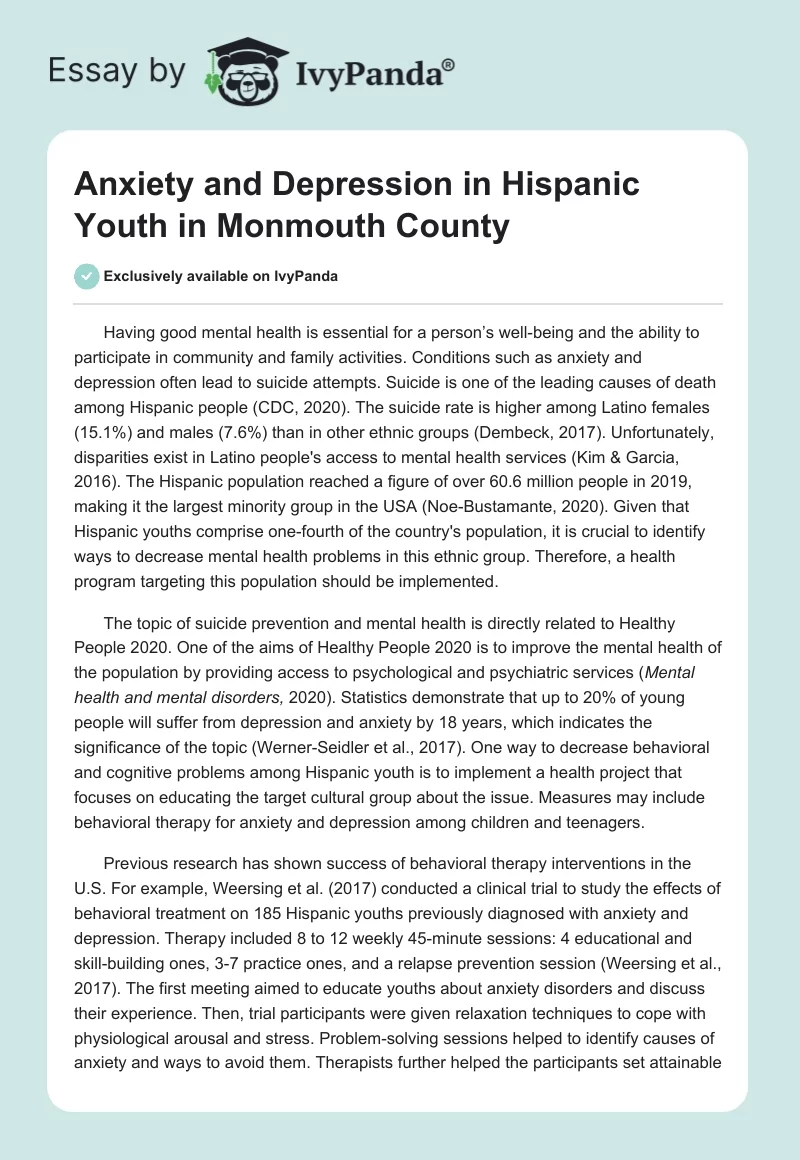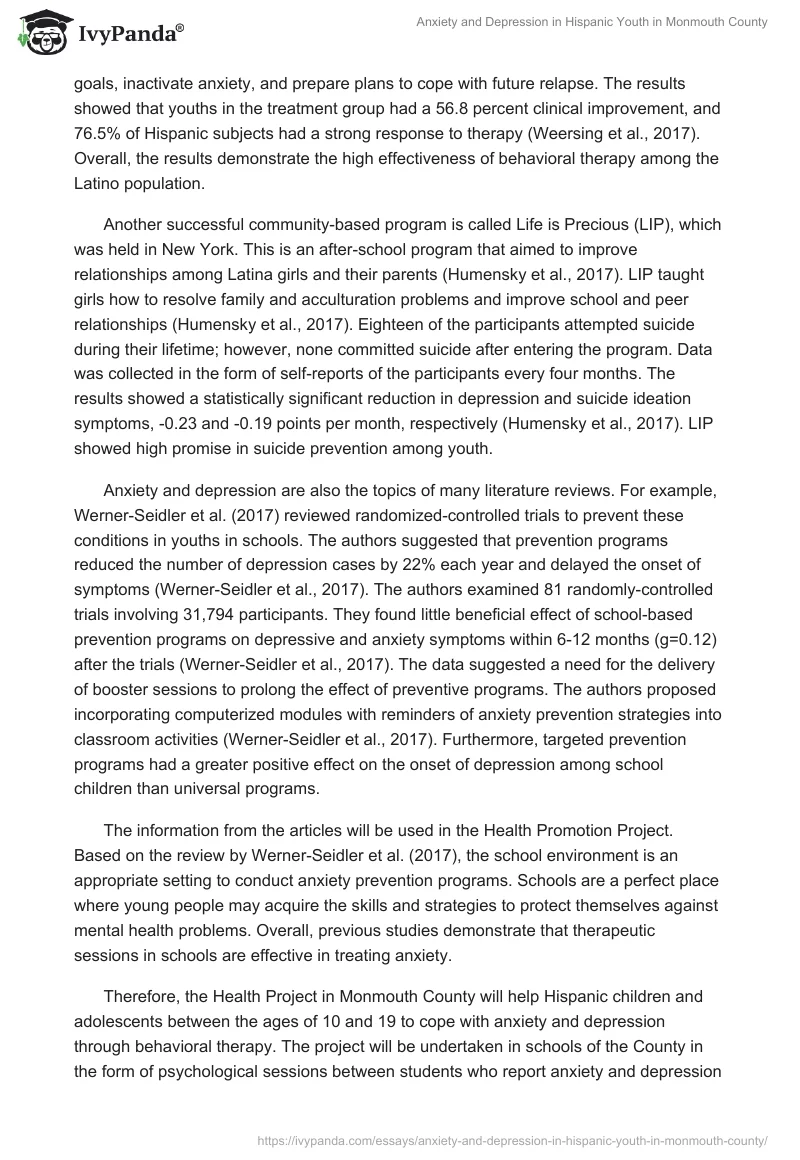Having good mental health is essential for a person’s well-being and the ability to participate in community and family activities. Conditions such as anxiety and depression often lead to suicide attempts. Suicide is one of the leading causes of death among Hispanic people (CDC, 2020). The suicide rate is higher among Latino females (15.1%) and males (7.6%) than in other ethnic groups (Dembeck, 2017). Unfortunately, disparities exist in Latino people’s access to mental health services (Kim & Garcia, 2016). The Hispanic population reached a figure of over 60.6 million people in 2019, making it the largest minority group in the USA (Noe-Bustamante, 2020). Given that Hispanic youths comprise one-fourth of the country’s population, it is crucial to identify ways to decrease mental health problems in this ethnic group. Therefore, a health program targeting this population should be implemented.
The topic of suicide prevention and mental health is directly related to Healthy People 2020. One of the aims of Healthy People 2020 is to improve the mental health of the population by providing access to psychological and psychiatric services (Mental health and mental disorders, 2020). Statistics demonstrate that up to 20% of young people will suffer from depression and anxiety by 18 years, which indicates the significance of the topic (Werner-Seidler et al., 2017). One way to decrease behavioral and cognitive problems among Hispanic youth is to implement a health project that focuses on educating the target cultural group about the issue. Measures may include behavioral therapy for anxiety and depression among children and teenagers.
Previous research has shown success of behavioral therapy interventions in the U.S. For example, Weersing et al. (2017) conducted a clinical trial to study the effects of behavioral treatment on 185 Hispanic youths previously diagnosed with anxiety and depression. Therapy included 8 to 12 weekly 45-minute sessions: 4 educational and skill-building ones, 3-7 practice ones, and a relapse prevention session (Weersing et al., 2017). The first meeting aimed to educate youths about anxiety disorders and discuss their experience. Then, trial participants were given relaxation techniques to cope with physiological arousal and stress. Problem-solving sessions helped to identify causes of anxiety and ways to avoid them. Therapists further helped the participants set attainable goals, inactivate anxiety, and prepare plans to cope with future relapse. The results showed that youths in the treatment group had a 56.8 percent clinical improvement, and 76.5% of Hispanic subjects had a strong response to therapy (Weersing et al., 2017). Overall, the results demonstrate the high effectiveness of behavioral therapy among the Latino population.
Another successful community-based program is called Life is Precious (LIP), which was held in New York. This is an after-school program that aimed to improve relationships among Latina girls and their parents (Humensky et al., 2017). LIP taught girls how to resolve family and acculturation problems and improve school and peer relationships (Humensky et al., 2017). Eighteen of the participants attempted suicide during their lifetime; however, none committed suicide after entering the program. Data was collected in the form of self-reports of the participants every four months. The results showed a statistically significant reduction in depression and suicide ideation symptoms, -0.23 and -0.19 points per month, respectively (Humensky et al., 2017). LIP showed high promise in suicide prevention among youth.
Anxiety and depression are also the topics of many literature reviews. For example, Werner-Seidler et al. (2017) reviewed randomized-controlled trials to prevent these conditions in youths in schools. The authors suggested that prevention programs reduced the number of depression cases by 22% each year and delayed the onset of symptoms (Werner-Seidler et al., 2017). The authors examined 81 randomly-controlled trials involving 31,794 participants. They found little beneficial effect of school-based prevention programs on depressive and anxiety symptoms within 6-12 months (g=0.12) after the trials (Werner-Seidler et al., 2017). The data suggested a need for the delivery of booster sessions to prolong the effect of preventive programs. The authors proposed incorporating computerized modules with reminders of anxiety prevention strategies into classroom activities (Werner-Seidler et al., 2017). Furthermore, targeted prevention programs had a greater positive effect on the onset of depression among school children than universal programs.
The information from the articles will be used in the Health Promotion Project. Based on the review by Werner-Seidler et al. (2017), the school environment is an appropriate setting to conduct anxiety prevention programs. Schools are a perfect place where young people may acquire the skills and strategies to protect themselves against mental health problems. Overall, previous studies demonstrate that therapeutic sessions in schools are effective in treating anxiety.
Therefore, the Health Project in Monmouth County will help Hispanic children and adolescents between the ages of 10 and 19 to cope with anxiety and depression through behavioral therapy. The project will be undertaken in schools of the County in the form of psychological sessions between students who report anxiety and depression in a survey and bilingual counseling psychologists. Handout materials will provide culturally and linguistically appropriate information for Hispanic youth. The sessions will be conducted both in English and Spanish, depending on student preferences. Art therapy and folktales can be incorporated into sessions as well. Risk factors and causes of depression, and measures of prevention will be discussed with the students during several psychological sessions. Specific problem-solving skills and strategies to avoid stress will be taught to students. For example, students can be told to have a conversation with a teacher about an unfinished homework instead of missing a class. Also, they could go for a walk outside while parents fight with each other at home. Participants of the program will be followed up every two months with reminders of strategies to cope with anxiety and depression in educational videos shown in classrooms.
In conclusion, the rise in mental health disorders such as anxiety and depression among the Latino population is a pressing issue that requires health professionals’ attention. Hispanic youths suffer from depression and anxiety more than their non-Latino peers and, consequently, have a higher suicide rate. Previous studies have shown the success of some anti-anxiety programs in young people of Hispanic origin. The researchers emphasized the importance of using linguistically appropriate content in brochures and communications between health professionals and treatment groups. One of the possible solutions to the problem is implementing a health program that would educate the target population of Monmouth County on the causes of depression and anxiety. The program will include culturally appropriate behavioral therapy sessions between school students and bilingual psychologists. Follow-up videos will be shown in classrooms as a reminder of anti-depression strategies every two months after the program.
References
CDC. Underlying cause of death 1999-2019 on CDC WONDER online database, released in 2020. Web.
Dembeck, E. S. (2017). Mental health and latino kids: a research review. RESEARCH REVIEW. Web.
Humensky, J. L., Coronel, B., Gil, R., Mazzula, S., & Lewis-Fernández, R. (2017). Life is precious: A community-based program to reduce suicidal behavior in latina adolescents. Archives of suicide research: official journal of the International Academy for Suicide Research, 21(4), 659–671. Web.
Kim, M., & Garcia, A. R. (2016). Measuring racial/ethnic disparities in mental health service use among children referred to the child welfare system. Child Maltreatment, 21(3), 218–227. Web.
Mental health and mental disorders. (2020). Healthy People. Web.
Noe-Bustamante, L., Lopez, M. H., & Krogstad, J. M. (2020). U.S. Hispanic population surpassed 60 million in 2019, but growth has slowed. Pew Research Center. Web.
Weersing, V. R., Brent, D. A., Rozenman, M. S., Gonzalez, A., Jeffreys, M., Dickerson, J. F., Lynch, F. L., Porta, G., & Iyengar, S. (2017). Brief behavioral therapy for pediatric anxiety and depression in primary care: A randomized clinical trial. JAMA psychiatry, 74(6), 571–578. Web.
Werner-Seidler, A., Perry, Y., Calear, A. L., Newby, J. M., & Christensen, H. (2017). School-based depression and anxiety prevention programs for young people: A systematic review and meta-analysis. Clinical Psychology Review, 51, 30–47. Web.


